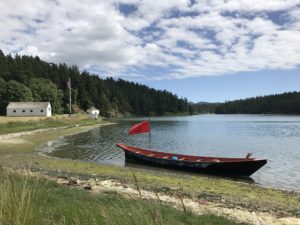 This week at English Camp we had some special visitors. A group of Coast Salish people came to share their heritage with us for Coast Salish Cultural Heritage Day.
This week at English Camp we had some special visitors. A group of Coast Salish people came to share their heritage with us for Coast Salish Cultural Heritage Day.
Long before the British set up English Camp, the ancestors of the Coast Salish fished and sought shelter in Garrison Bay. The Bay is a protected harbor and the indigenous people stayed here in the winter for over 1,800 years. They left a shell midden (garbage heap made of shells) that was 10 feet tall and spread over an area about the size of a football field. By the time the British set up English Camp, the area was rarely used by the native people.
The Coast Salish are the descendants of the indigenous people that camped during the winters off Garrison Bay. Coast Salish is a term that groups the tribes that are joined by a common language and cultural origin. People from several different bands came to the Cultural Heritage Day and shared some of their traditions with us. They represented the Saanich, the Samish, and the Skokomish bands. There were also some students and professors from Edmonds Community College.
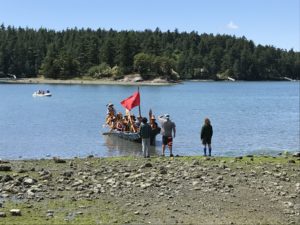 The event started with the arrival of a traditional Coast Salish wooden canoe on Wednesday. The canoe started in Anacortes, went to Shaw Island, stayed for a night in Orcas Island, and then arrived in Garrison Bay. The journey represented the journeys made by their ancestors as they used the islands for shelter. Because they came in friendship, they asked permission to land. Our park superintendent, Elexis Fredy welcomed them and invited them to come ashore.
The event started with the arrival of a traditional Coast Salish wooden canoe on Wednesday. The canoe started in Anacortes, went to Shaw Island, stayed for a night in Orcas Island, and then arrived in Garrison Bay. The journey represented the journeys made by their ancestors as they used the islands for shelter. Because they came in friendship, they asked permission to land. Our park superintendent, Elexis Fredy welcomed them and invited them to come ashore.
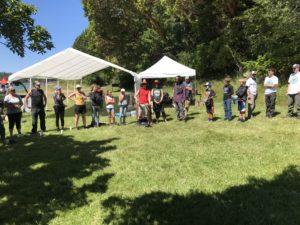 Thursday the day began with a Gathering Circle. One of the things we found rather unique about the Coast Salish is that they feel that relationships are more important than time. They wouldn’t give us a time for anything they were doing! When I asked what time the Gathering Circle would begin, they told me “When the people have gathered.” Later in the day a tour guide for the Road Scholars asked them when the tourists could have a canoe ride and were told “soon.” It was an hour before any of them got on a canoe. Things were done when the people were ready and speeches and ceremonies took as long as they needed. For those of us who are time-oriented, it took some getting used to.
Thursday the day began with a Gathering Circle. One of the things we found rather unique about the Coast Salish is that they feel that relationships are more important than time. They wouldn’t give us a time for anything they were doing! When I asked what time the Gathering Circle would begin, they told me “When the people have gathered.” Later in the day a tour guide for the Road Scholars asked them when the tourists could have a canoe ride and were told “soon.” It was an hour before any of them got on a canoe. Things were done when the people were ready and speeches and ceremonies took as long as they needed. For those of us who are time-oriented, it took some getting used to.
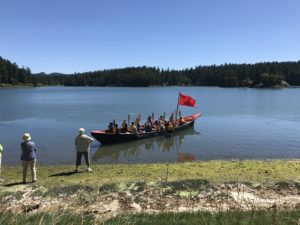 After the Gathering Circle, the Coast Salish demonstrated some traditional games and wove cedar hats. Some of the women made fry bread and worked on preparing lunch. One man led hikes where visitors could meet the “animal people.” The men gave speeches and sang with drum accompaniment. During the afternoon they gave park visitors rides in the canoe. They paddled around Guss Island. The Coast Salish believe that Guss Island is where their nation began, so it is a very important place to them.
After the Gathering Circle, the Coast Salish demonstrated some traditional games and wove cedar hats. Some of the women made fry bread and worked on preparing lunch. One man led hikes where visitors could meet the “animal people.” The men gave speeches and sang with drum accompaniment. During the afternoon they gave park visitors rides in the canoe. They paddled around Guss Island. The Coast Salish believe that Guss Island is where their nation began, so it is a very important place to them.
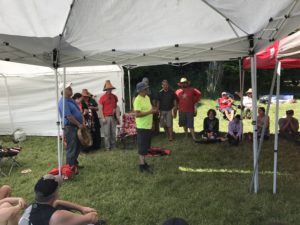 In the afternoon the Elders spoke about how important the land of English Camp is to them. Many of them cried as they talked about how powerful it was to come back to English Camp. Each Elder spoke as long as he or she wanted and the visitors listened politely. It was wonderful to see people being so respectful of their traditions. In the Gathering Circle, one of the Elders told us, “Do not learn our traditions by reading or watching YouTube. Learn our traditions by listening to us and ask if you have questions.”
In the afternoon the Elders spoke about how important the land of English Camp is to them. Many of them cried as they talked about how powerful it was to come back to English Camp. Each Elder spoke as long as he or she wanted and the visitors listened politely. It was wonderful to see people being so respectful of their traditions. In the Gathering Circle, one of the Elders told us, “Do not learn our traditions by reading or watching YouTube. Learn our traditions by listening to us and ask if you have questions.”
It was an interesting day and I learned a lot. We will see many of these folks again next month when they are joined by more canoes as part of a Coast Salish Canoe Journey. They will be camping here at English Camp overnight on their journey. I look forward to seeing them again and learning even more.

One comment